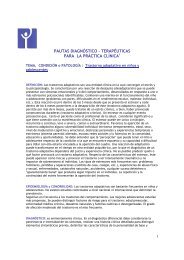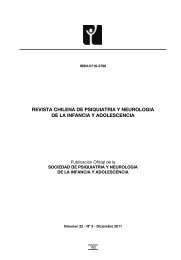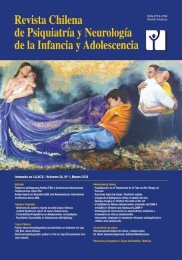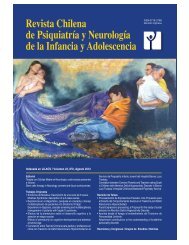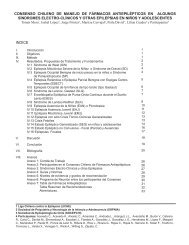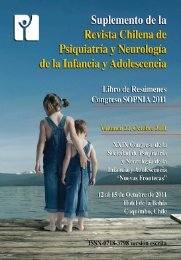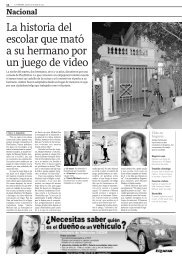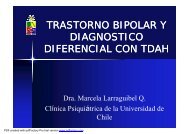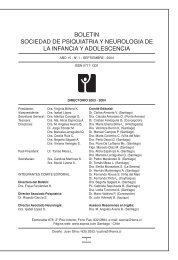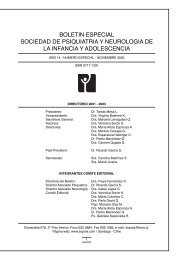TRABAJO ORIGINALRev. Chil. Psiquiatr. Neurol. Infanc. Adolesc. Volumen 22, Nº 2, Agosto 2011Perfil clínico <strong>de</strong> patología neuromuscu<strong>la</strong>r hereditariaen el Instituto <strong>de</strong> Rehabilitación Infantil Teletón, Valparaíso,ChileClinical profile of patients with neuromoscu<strong>la</strong>r hereditary diseases inChild Rehabilitation Institute Teletón, Valparaiso, Chile.Joyce Lavanchy (1) , Catalina Rojas (2) , Bernardita Suárez (3) , Karina Rosso (2) , Yerka Luksic (2) ,Estebeni Baltra (2) , Fernando Novoa (4)RESUMENIntroducción: Las enfermeda<strong>de</strong>s neuromuscu<strong>la</strong>res (ENM) son una causa importante <strong>de</strong> discapacidadprogresiva en el niño. Objetivo: Describir el perfil clínico <strong>de</strong> <strong>la</strong>s consultas por ENM hereditarias,atendidas actualmente en Instituto <strong>de</strong> Rehabilitación Infantil Teletón (IRI), Valparaíso.Pacientes y Método: estudio <strong>de</strong>scriptivo, retrospectivo. Selección y análisis <strong>de</strong> pacientes conENM en control activo, <strong>de</strong>l registro estadístico <strong>de</strong> IRI Valparaíso. Resultados: Total 115 pacientes,hombres 70%. Edad promedio 14,9 años (rango: 1-28 a). Motivo <strong>de</strong> consulta más frecuente:trastorno <strong>de</strong> <strong>la</strong> marcha (49,5%). Las etiologías encontradas fueron: muscu<strong>la</strong>r (67%), neuropatías(21%) y enfermedad <strong>de</strong> motoneurona (10%). Los diagnósticos más frecuentes fueron: Distrofinopatías30%, Charcot Marie Tooth 21,7%, Miopatías Congénitas 15,6%, Atrofia Muscu<strong>la</strong>rEspinal 10%, Distrofia Miotónica 7,8%. Discusión: El sexo masculino fue más prevalente lo quepue<strong>de</strong> atribuirse a <strong>la</strong> mayor frecuencia <strong>de</strong> Distrofinopatías <strong>de</strong>ntro <strong>de</strong> <strong>la</strong>s ENM. La <strong>la</strong>tencia parael diagnóstico es variable según <strong>la</strong> patología, siendo en promedio 3,2 años. Las frecuencias <strong>de</strong>diagnósticos encontrados coinci<strong>de</strong>n parcialmente con <strong>la</strong> epi<strong>de</strong>miología <strong>de</strong>scrita.Pa<strong>la</strong>bras c<strong>la</strong>ves: neuromuscu<strong>la</strong>r, hereditaria, epi<strong>de</strong>miología, IRI Valparaíso.ABSTRACTIntroduction: Neuromuscu<strong>la</strong>r diseases (NMD) are a major cause of progressive disability in children.Objective: To <strong>de</strong>scribe the clinical profile of hereditary NMD consultations, currently beingatten<strong>de</strong>d in IRI Valparaíso. Patients and Method: Selection and analysis of actually attendingNMD patients from the IRI statistical registration. Results: 115 patients were i<strong>de</strong>ntified, 70%men. Mean age 14.9 years (1-28). The most frequent cause for consultation was gait disor<strong>de</strong>r(49.5%). Etiologies were: muscu<strong>la</strong>r (67%), neuropathy (21%) and motor neuron disease (10%).The most common diagnoses were: dystrophinopathies (30%), Charcot Marie Tooth 21.7%,Congenital Myopathy (15.6%), Spinal Muscu<strong>la</strong>r Atrophy (10%), Myotonic Dystrophy (7.8%). Discussion:Prevalence was higher for males, which is attributed to the higher frequency of dystrophinopathies.Time for diagnosis was variable <strong>de</strong>pending on the disease, with a mean of 3,2years. The frequency of NMD were partially coinci<strong>de</strong>ntal with previously reported epi<strong>de</strong>miologicdata.Key words: neuromuscu<strong>la</strong>r, hereditary, epi<strong>de</strong>miology, IRI Valparaíso.1 Médico Fisiatra, Instituto <strong>de</strong> Rehabilitación Infantil (IRI)Teletón, Valparaíso, Chile.2 Médico, Programa <strong>de</strong> Formación en Neuropediatría,Universidad <strong>de</strong> Valparaíso, Hospital Carlos van Buren,Valparaíso, Chile.3 Médico Neuropediatra, Instituto <strong>de</strong> Rehabilitación Infantil(IRI) Teletón, Valparaíso, Chile.4 Médico Neuropediatra, Director <strong>de</strong>l Programa <strong>de</strong> Formaciónen Neuropediatría, Universidad <strong>de</strong> Valparaíso,Hospital Carlos van Buren, Valparaíso, Chile.134
Joyce Lavanchy et alINTRODUCCIÓNEl Instituto <strong>de</strong> Rehabilitación Infantil Teletón(IRI) Valparaíso es un organismo que tienecomo objetivo <strong>la</strong> rehabilitación <strong>de</strong> niños condiscapacida<strong>de</strong>s físicas; a él asisten hoy granparte <strong>de</strong> los pacientes <strong>de</strong> <strong>la</strong> V Región.Las enfermeda<strong>de</strong>s neuromuscu<strong>la</strong>res (ENM)son un grupo amplio <strong>de</strong> patologías en <strong>la</strong>s quese afecta alguno <strong>de</strong> los componentes <strong>de</strong> <strong>la</strong>unidad motora, formada por <strong>la</strong> motoneuronaque se encuentra tanto en el asta anterior <strong>de</strong> <strong>la</strong>médu<strong>la</strong> espinal como en los núcleos motores<strong>de</strong> tronco encefálico, su axón, <strong>la</strong> unión neuromuscu<strong>la</strong>ry <strong>la</strong>s miofibril<strong>la</strong>s que inerva (1).Este grupo <strong>de</strong> patologías presentan inci<strong>de</strong>nciavariada <strong>de</strong>pendiendo <strong>de</strong>l tipo enfermedad,<strong>de</strong>s<strong>de</strong> 1:3.500 en <strong>la</strong> Distrofia Muscu<strong>la</strong>r <strong>de</strong>Duchenne (DMD), 1:6.000 en Atrofia Espinal(AME) (2), hasta 0.77/100.000 en el caso <strong>de</strong> <strong>la</strong>miopatía <strong>de</strong> Bethlem (3).Las (ENM) son una causa importante <strong>de</strong> discapacidadprogresiva en el niño (4). A pesar<strong>de</strong> que cada año se sabe más <strong>de</strong> <strong>la</strong> fisiopatología<strong>de</strong> estas enfermeda<strong>de</strong>s (5), hasta <strong>la</strong>fecha no existe un tratamiento curativo paramuchas <strong>de</strong> el<strong>la</strong>s. Así, <strong>la</strong> terapia <strong>de</strong> rehabilitaciónse presenta como una alternativa efectivapara enlentecer, modificar <strong>la</strong> progresión <strong>de</strong> <strong>la</strong>enfermedad y mejorar <strong>la</strong> calidad <strong>de</strong> vida siendoparte esencial <strong>de</strong> <strong>la</strong>s recomendaciones <strong>de</strong>manejo en DMD y AME (6) (7).El objetivo general <strong>de</strong> este trabajo es <strong>de</strong>scribirel perfil clínico <strong>de</strong> <strong>la</strong>s consultas por ENM hereditariasatendidas actualmente en IRI Valparaíso,<strong>de</strong> modo <strong>de</strong> conocer el panorama local <strong>de</strong><strong>la</strong> V Región, consi<strong>de</strong>rando que gran parte <strong>de</strong>los niños con discapacidad física secundariaa ENM se atien<strong>de</strong>n en este centro. Dentro <strong>de</strong>los objetivos específicos se p<strong>la</strong>ntea conocerlo diagnósticos más frecuentes, motivos <strong>de</strong>primera consulta, así como <strong>la</strong>s <strong>la</strong>tencias parallegar a diagnósticos específicos. Finalmentecomparar estos datos con otras series publicadas.PACIENTES Y MÉTODOSe realizó un estudio retrospectivo, <strong>de</strong>scriptivo.Se incluyeron pacientes en control activocon diagnóstico <strong>de</strong> ENM hereditaria <strong>de</strong>lregistro estadístico <strong>de</strong>l IRI. Los criterios <strong>de</strong> exclusiónfueron: pacientes con patologías neuromuscu<strong>la</strong>resadquiridas tales como: Guil<strong>la</strong>inBarré, Miastenia Gravis y Miopatías inf<strong>la</strong>matorias,entre otras. Se revisaron fichas clínicas<strong>de</strong> los pacientes extrayendo datos para análisisestadístico. Se recopi<strong>la</strong>ron los siguientesdatos aportados por <strong>la</strong> anamnesis y examenfísico: edad, sexo, edad <strong>de</strong> presentación, motivo<strong>de</strong> consulta, historia clínica, edad <strong>de</strong> diagnóstico,antece<strong>de</strong>ntes familiares; exámenes <strong>de</strong><strong>la</strong>boratorio: CK total, velocidad <strong>de</strong> conducciónnerviosa (VCN), electromiografía (EMG), biopsiamuscu<strong>la</strong>r, estudio genético y <strong>de</strong> imágenes(TAC/RM). El diagnóstico específico se <strong>de</strong>terminóen base a <strong>la</strong> historia clínica compatible yexámenes <strong>de</strong> <strong>la</strong>boratorio que lo confirmaron(VCN, EMG y/o biopsia muscu<strong>la</strong>r). En el caso<strong>de</strong> <strong>la</strong>s afecciones primariamente muscu<strong>la</strong>resel diagnóstico se basó en <strong>la</strong> historia clínica,exámen físico y exámenes <strong>de</strong> <strong>la</strong>boratorio (CKtotal y biopsia muscu<strong>la</strong>r confirmatoria -patróndistrófico o miopático <strong>de</strong> acuerdo a tincionesbásicas <strong>de</strong> hematoxilina eosina, Gomori, COX,NADH e inmunohistoquímica según sospechaclínica). No se exigió estudio genético parael diagnóstico, sin embargo en caso positivose consi<strong>de</strong>ró otro elemento confirmatorio (ej.DMD). En el caso <strong>de</strong> <strong>la</strong>s neuropatías y enfermeda<strong>de</strong>s<strong>de</strong> motoneurona se exigió parael diagnóstico una historia clínica compatibleconfirmada con estudio electrofisiológico(VCN y EMG). La <strong>la</strong>tencia diagnóstica fue <strong>de</strong>finidacomo el tiempo transcurrido entre el inicio<strong>de</strong> los síntomas y el diagnóstico específicoLos datos fueron recolectados y analizados enp<strong>la</strong>nil<strong>la</strong> Excel.RESULTADOSRev. Chil. Psiquiatr. Neurol. Infanc. Adolesc.Agosto 2011De un total <strong>de</strong> 4.102 pacientes que actualmentese atien<strong>de</strong>n en este centro, se i<strong>de</strong>ntificóa 115 pacientes con ENM, que constituyen un9,4% <strong>de</strong> <strong>la</strong>s nuevas consultas y un 9,3% <strong>de</strong>135



